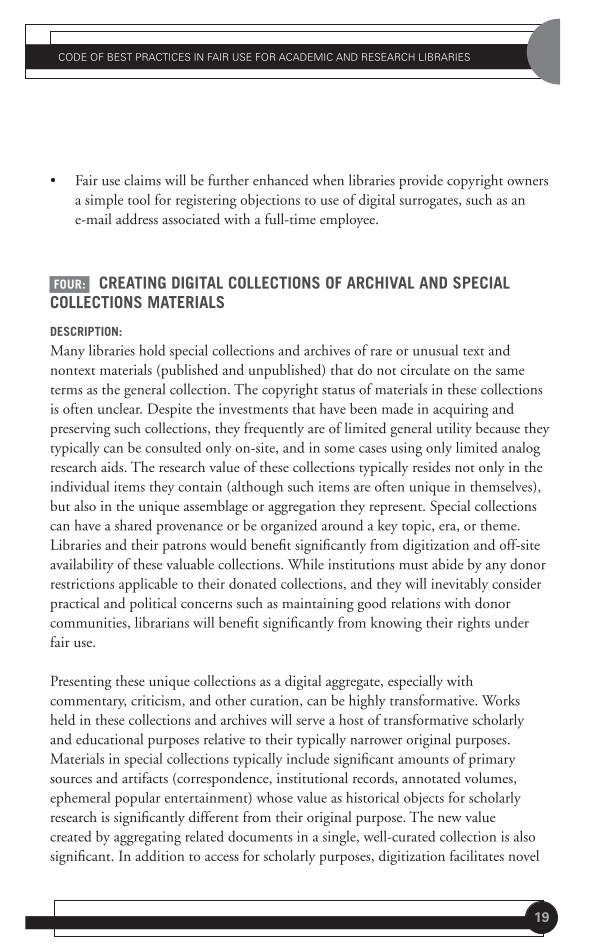CODE OF BEST PRACTICES IN FAIR USE FOR ACADEMIC AND RESEARCH LIBRARIES
19
• Fair use claims will be further enhanced when libraries provide copyright owners
a simple tool for registering objections to use of digital surrogates, such as an
e-mail address associated with a full-time employee.
FOUR: CREATING DIGITAL COLLECTIONS OF ARCHIVAL AND SPECIAL
COLLECTIONS MATERIALS
DESCRIPTION:
Many libraries hold special collections and archives of rare or unusual text and
nontext materials (published and unpublished) that do not circulate on the same
terms as the general collection. The copyright status of materials in these collections
is often unclear. Despite the investments that have been made in acquiring and
preserving such collections, they frequently are of limited general utility because they
typically can be consulted only on-site, and in some cases using only limited analog
research aids. The research value of these collections typically resides not only in the
individual items they contain (although such items are often unique in themselves),
but also in the unique assemblage or aggregation they represent. Special collections
can have a shared provenance or be organized around a key topic, era, or theme.
Libraries and their patrons would benefit significantly from digitization and off-site
availability of these valuable collections. While institutions must abide by any donor
restrictions applicable to their donated collections, and they will inevitably consider
practical and political concerns such as maintaining good relations with donor
communities, librarians will benefit significantly from knowing their rights under
fair use.
Presenting these unique collections as a digital aggregate, especially with
commentary, criticism, and other curation, can be highly transformative. Works
held in these collections and archives will serve a host of transformative scholarly
and educational purposes relative to their typically narrower original purposes.
Materials in special collections typically include significant amounts of primary
sources and artifacts (correspondence, institutional records, annotated volumes,
ephemeral popular entertainment) whose value as historical objects for scholarly
research is significantly different from their original purpose. The new value
created by aggregating related documents in a single, well-curated collection is also
significant. In addition to access for scholarly purposes, digitization facilitates novel
19
• Fair use claims will be further enhanced when libraries provide copyright owners
a simple tool for registering objections to use of digital surrogates, such as an
e-mail address associated with a full-time employee.
FOUR: CREATING DIGITAL COLLECTIONS OF ARCHIVAL AND SPECIAL
COLLECTIONS MATERIALS
DESCRIPTION:
Many libraries hold special collections and archives of rare or unusual text and
nontext materials (published and unpublished) that do not circulate on the same
terms as the general collection. The copyright status of materials in these collections
is often unclear. Despite the investments that have been made in acquiring and
preserving such collections, they frequently are of limited general utility because they
typically can be consulted only on-site, and in some cases using only limited analog
research aids. The research value of these collections typically resides not only in the
individual items they contain (although such items are often unique in themselves),
but also in the unique assemblage or aggregation they represent. Special collections
can have a shared provenance or be organized around a key topic, era, or theme.
Libraries and their patrons would benefit significantly from digitization and off-site
availability of these valuable collections. While institutions must abide by any donor
restrictions applicable to their donated collections, and they will inevitably consider
practical and political concerns such as maintaining good relations with donor
communities, librarians will benefit significantly from knowing their rights under
fair use.
Presenting these unique collections as a digital aggregate, especially with
commentary, criticism, and other curation, can be highly transformative. Works
held in these collections and archives will serve a host of transformative scholarly
and educational purposes relative to their typically narrower original purposes.
Materials in special collections typically include significant amounts of primary
sources and artifacts (correspondence, institutional records, annotated volumes,
ephemeral popular entertainment) whose value as historical objects for scholarly
research is significantly different from their original purpose. The new value
created by aggregating related documents in a single, well-curated collection is also
significant. In addition to access for scholarly purposes, digitization facilitates novel


































